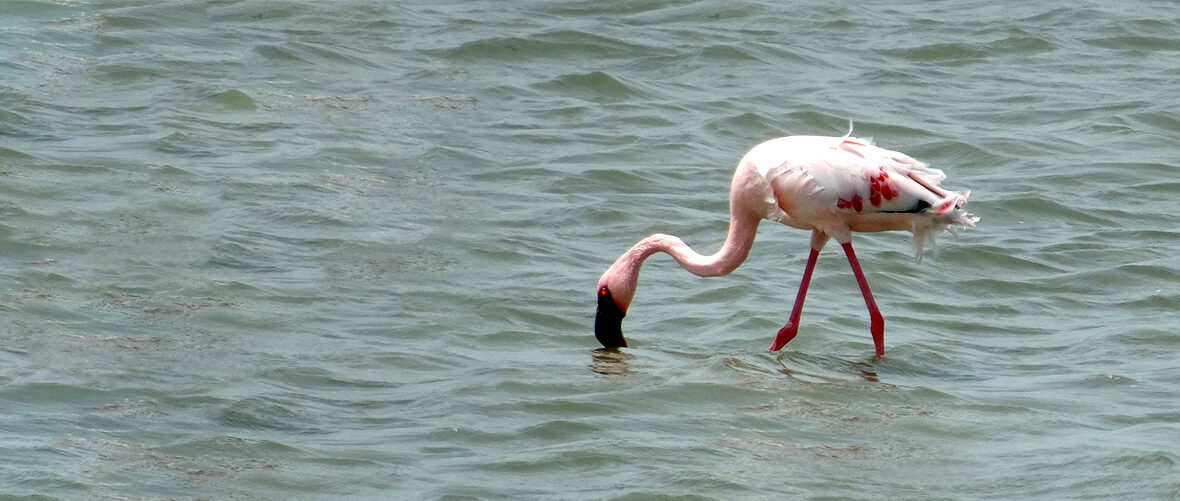
The lesser flamingo is the smallest of the flamingos but has the largest distribution. They can be found congregating in sub-Saharan Africa, Saudi Arabia, Madagascar, and India. They prefer large alkaline and saline lakes, coastal lagoons, and salt pans. Due to habitat loss and destruction at the hands of mining, quarrying, utility & service lines, and dams; human disturbances; pollution; and climate change, that causes draughts, these birds are listed as Near Threatened by the IUCN. Their numbers are also decreasing. Happy Earth Day to everyone!
First the Stats…
Scientific name: Phoeniconaias minor
Weight: Up to 5 lbs.
Length: Up to 41 inches
Wingspan: Up to 39 inches
Lifespan: Up to 50 years
Now on to the Facts!
1.) Lesser flamingos are gregarious birds that can live in huge colonies of up to 1,000,000+ individuals.
2.) These birds are predominantly nocturnal (active at night).
3.) Even though they aren’t migratory, they will fly from 1 body of water to the next in search of food, when their food source is depleted.
4.) They fly in a V formation. And if you’re wondering why 1 line of birds in the V formation is longer than the other… it’s because there are more birds in that line. (Dad joke).
5.) Their eyesight and hearing are keen.
But wait, there’s more on the lesser flamingo!
6.) Parents are capable of discerning their own chicks by the sound of their calls.
7.) A group of flamingos is called a colony, flamboyance, regiment, or stand.
Did you know…?
The lesser flamingo has no sense of smell and nearly no sense of taste.
8.) These birds are herbivores that mostly consume blue-green algae (spirulina), however they will also sometimes feed on crustaceans, zooplankton, and small insects.
9.) The lesser flamingo is serially monogamous (mates with just 1 partner during the breeding season, only to pair with another during the next season).
10.) Breeding season lasts from October – December.
But wait, there’s still more on the lesser flamingo!
11.) Nests are built of mud and measure up to 11.81 inches tall.
12.) Females lay a single egg that hatches in up to 28 days.
Did you know…?
Chicks learn to run at just 7 days old. They get their feathers at 4 weeks, and can fly at 12 weeks old.
13.) Both parents take turns incubating the egg.
14.) The parents feed their chick with a substance called crop milk (regurgitated food from their digestive tract).
15.) At just 6 days old, chicks join a crèche with thousands of other chicks. They must then learn to call for their parents, who are able to identify their own chick from the hundreds of thousands of others.
But wait, there’s still a little more on the lesser flamingo!
16.) A threat to their existence is the fact that humans will collect flamingo eggs, which not only prohibits the chicks from ever being born, but also disturbs the rest of the colony.
17.) There are upwards of 3.3 million lesser flamingos in the wild, to date.
Did you know…?
Ancient Egyptians utilized the flamingo’s silhouette as a hieroglyphic for the color “red”, and they also used the flamingo for the reincarnation of the Sun God Ra.
18.) Being a very noisy species, their in-flight call is a “kwirrik” sound. During wading and feeding they produce a mumbling “murrrh-murrrh-errh” sound.
19.) While normally seen standing in the water, these birds are also excellent swimmers too.
20.) Their flocks, as mentioned, can number over 1,000,000 strong. It’s among the largest flock of any bird on earth.
But wait, there’s still a tad more on the lesser flamingo!
21.) The most comfortable standing position for flamingos is on 1 leg.
22.) Flamingos date back as far as the Miocene epoch (10 million years ago).
23.) Unlike other flamingos that dip their head into the water to feed, the lesser flamingos just skim the water’s surface for food.
24.) Lions, cheetahs, leopards, jackals, and pythons all prey on lesser flamingos.
Now a Short Lesser Flamingo Video!
Be sure to share & comment below! Also, check out the Critter Science YouTube channel. Videos added regularly!
Want to suggest a critter for me to write about? Let me know here.
Some source material acquired from: Wikipedia & IUCN



